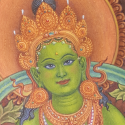Description
Green Tara Newari Thangka Painting is hand painted with water mineral colors, stone colors by Newari artist living in Bhaktapur Nepal.
Green Tara symbolizes the female side of wisdom activity in our mind and is basically an emanation of the air-element (Amoghsiddhi Buddha). She is also called ‘Mother of All Buddhas’ and has many peaceful and wrathful forms.
It creates a spiritual environment and inspires you to be more compassionate kind and even encourage you to do meditate or do your prayers with even more dedication and grace. You can place this thangka on the walls when you are doing Tara pooja or reciting Tara mantras.
Attributes of Green Tara Newari Thangka Painting
- Hand-painted on cotton canvas
- Dimensions: cm
- Materials: Cotton Canvas, Poster color, Mixed Gold
- Skill and Origin: Handmade in Nepal
- Category: Newari Thangka paintings, Spirituality
- Use: Meditation, decoration, gift
Introduction of Green Tara
Samaya Tara, popularly known as Green Tara. She is represented in a royal ease posture with her left leg bent her left leg overstepping the main lotus and resting on a blue lotus ready to get up and offer assistance to those in need.
She is portrayed with maroon Buddhist robes and jewelry. The earrings represent patience, understanding, and renunciation. The diadem with five jewels represents the transmutation of the five delusions into the Five Buddha Wisdoms. She is shown with a benevolent countenance seated upon a white moon disk which is associated with special restorative nectar associated with the naval chakra center.
In Buddhist, the moon symbolizes the wisdom aspect which when coupled with compassion lead to Sakyamuni Buddha’s enlightenment. Her right hand is gracefully lowered in varada mudra, the boon-granting gesture.
The iconography of Green Tara
Green Tara’s special lotus is the blue lotus or ‘night lotus’ which she bears in both hands. The word utpala means to ‘burst open’.
Her left hand holds a stem with an open blooming flower and an unopened bud. The bent lower part of the stem represents the root.
The open blossom represents the present and also the present Buddha; the bud represents the future and also Buddhas yet to be born. The future here also refers to a safe journeys end and a future well being.
Her right-hand wisdom hand is in the gesture of giving refuge. The third finger touches the thumb to create a circle representing the union of wisdom and compassion, and the three extended fingers symbolize the Three Jewels of Buddhism.
- The Buddha State
- The Body of teachings
- The Principles of the Universe
The same hand holds the stem of a blue lotus representing her willingness to assist. The closed blossom in her right hand represents the past and also the Buddhas of the past. Green Tara is shown in a place of paradise called Khadiravani where she Tara dwells.
Khadiravani is described as a great mountain kingdom with many trees, flowers, and animals (not shown).
Three rainbow tails emanate from her outer aureole. The crescent moon and sun symbolize the union of male and female ubiquitous in Tantric art.
The seventy-two golden lines represent psychic energy channels emanate from her body and her central psychic channel running up her spinal column.
Each one signifies a thousand as there are traditionally seventy-two thousand channels. The gold lines alternate between wiggly and straight to represent the two main psychic channels running up the central channel that entwine to create the interlocking ‘snaking’ caduceus and to which the energy channels are connected. The trees in the foreground are the Ashoka Tree.
The word Ashoka means ‘without sorrow’ and is the tree linked to the Vedic God of love and sexual union Kamadeva. Apparently, the tree blossoms when a virtuous lady touches it.
The word Tara means the one who saves. The word Tara is derived from the root tri meaning to cross and in context is taken to mean the one who helps people to cross the Ocean of Existence and Suffering. Green Tara is also called ‘dark’ Tara or more directly Shyama Tara.
Green Tara is associated with the Amoghasiddhi who is also green and the north facing Meditation who is head of the active family. Her willingness to help others is shown by her body posture with one foot ready so that she can rise to offer assistance. Like WhiteTara, she was born of the tears of compassion of the Bodhisattva Avalokiteshvara, resulting from the extreme state of sadness he experienced when observing the continuing ceaseless suffering which he sought to end.
Paubha is a traditional religious painting made by the Newar people of Nepal.
Paubhas depict deities, mandalas or monuments, and are used to help the practitioner meditate. The Tibetan equivalent is known as Thangka.
What is the difference between Paubha and Thangka?
In Newari community, Thangka is called as Paubha. In the Tibetan community, the same is known as Thangkas.
Newari Art, Paubha are handpainted by the Newari community living in Kathmandu Nepal which used for meditation and also is displayed during festivals and other special occasions.
Newari art is very fine art which will take 2 to 3 months to complete one paubha.
Most paubhas show Buddhist subjects, but a few have Hindu themes. The paintings are made to earn religious merit both for the artist and the patron.
Newar Buddhists commission artists to paint paubhas which are displayed during festivals and other special occasions.
The traditional painters of paubhas are the Chitrakar caste who are known as Pun in Nepali.
To know more about green Tara please read the article All about Green Tara.
For custom size, design and bulk order please contact us.
























Reviews
There are no reviews yet.